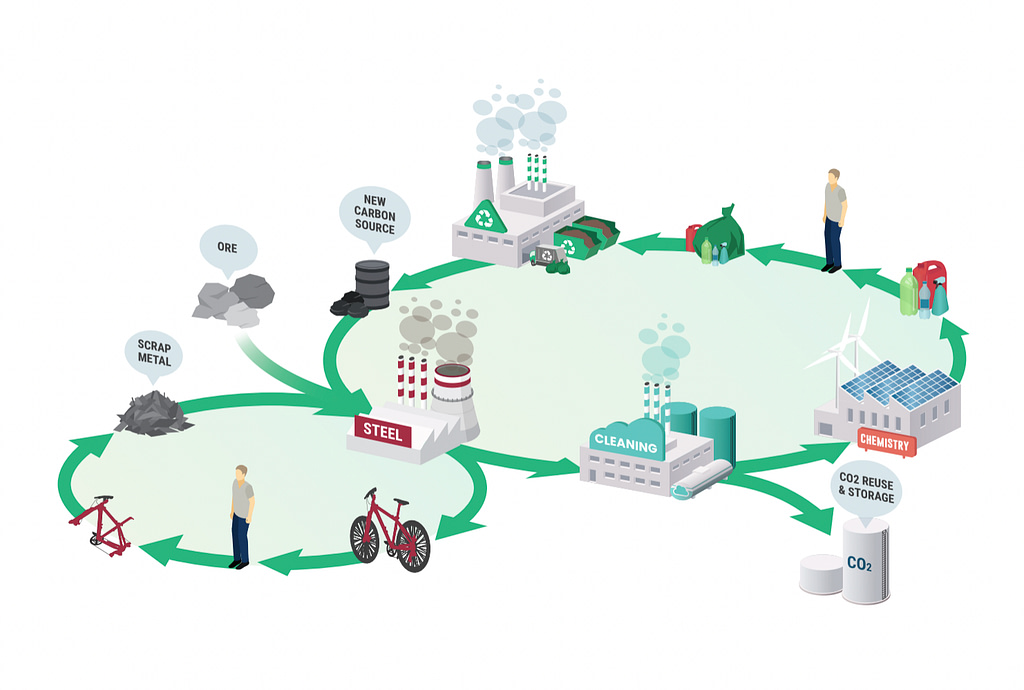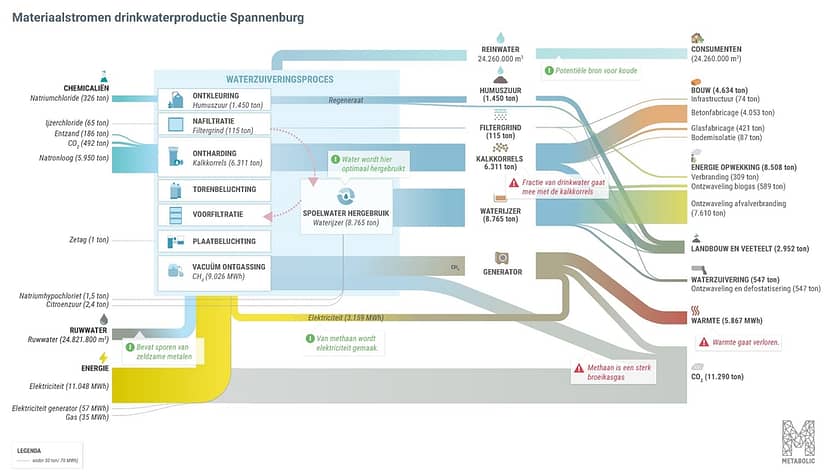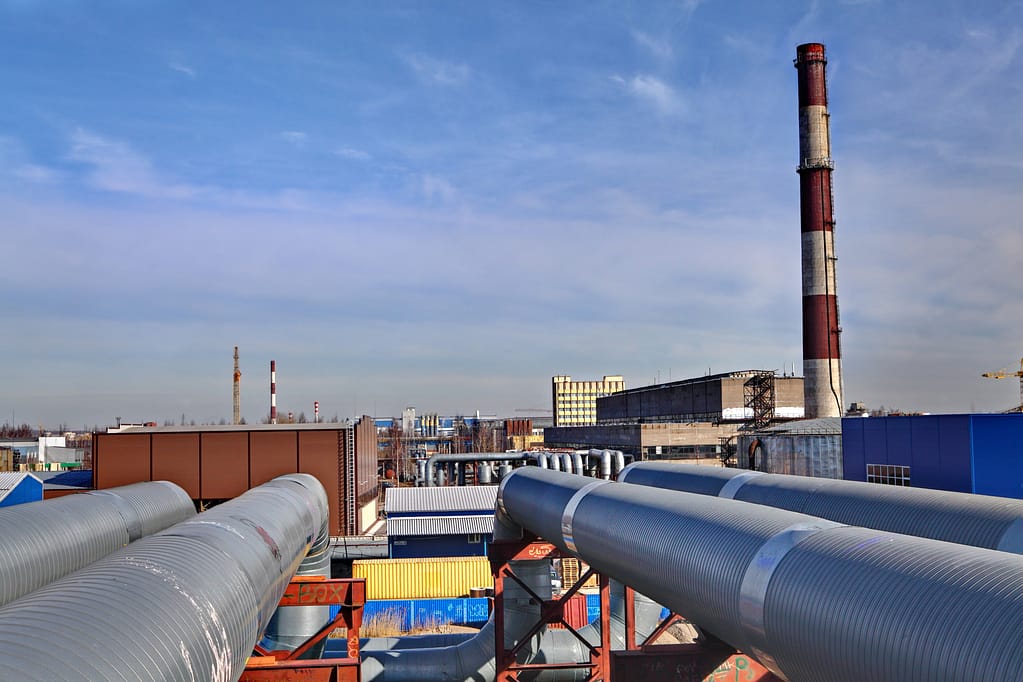Like an ecological system in which living organisms interact in a mutually beneficial relationship, companies can also form a system that optimizes their use of materials in a way that benefits everyone.
An old adage maintains: one man’s trash is another man’s treasure. The same holds true for industrial waste. Waste or “output” produced by one company, at the end of its production process, can be reborn into a valuable raw material or “input” for another. The scale of industrial processes can mean a lot of mass, a lot of value, and vastly reduced impacts. This is the idea behind industrial symbiosis, a practice long mastered in Kalundborg, Denmark.
An industrial ecology mecca, a cluster of companies in Kalundborg have known for decades that sharing waste means reducing waste—and making money off the process. A coal-fired power plant there sells the heated water it generates to a nearby fish farm. A pharmaceutical company’s organic byproducts used in testing go to farmers to fertilize their fields.
Economically, exchanges of waste such as in Kalundborg generate profit and reduce costs on energy and waste disposal. Environmentally, they reduce carbon dioxide emissions and reduce pollution without compromising economic development. Socially, materials recycling processes create waste management jobs and provide people and wildlife with a cleaner landscape. Letting excess material, water, or energy generated by an industrial process go to waste is, simply put, a missed opportunity.
A net-zero approach to industrial waste
Like an ecological system in which living organisms interact in a mutually beneficial relationship, companies can also form a system that optimizes their use of materials in a way that makes inputs economically valuable for longer. Exchange of material and energy flows can be optimized such that they cycle in a symbiotic loop. Industrial waste streams tend to be (1) huge, and (2) relatively clean, easier to sort than municipal waste. A company looking for, for example, clear glass, could sort through hundreds of tons of municipal trash or mixed recycling streams, but the waste of a glass-cutting industry will likely be uniform, uncontaminated, and readily available. The same goes for plastics, metals, organic wastes, paper. Fish scales from fish cleaning factories. Rubber from tire manufacturing. Even ash.

Eco-industrial parks promote resource efficiency
The quintessential setting for industrial symbiosis is among factories operating within close proximity of each other in eco-industrial parks (EIP).
Take, for example, South Korea’s Eco-Industrial Park Initiative, where firms in the Ulsan Mipo and Onsan Industrial Park “invested some $520 million in energy efficiency, industrial symbiosis, waste management, and other eco-friendly improvements. To date, the investment has yielded $554 million in savings, while firms in the EIP generated $91.5 billion in revenues,” according to the World Bank.
The area comprises 1,000 companies in industries as diverse as vehicle manufacturing, shipbuilding, and oil refining. “With $14.8 million in government support, companies reduced their CO2 emissions in 2015–2016 by 665,712 tons, reused 79,357 tons of water, and saved 279,761 tons of oil equivalent in energy use.”
On the social impact front, this successful EIP enhanced relations with local communities by countering negative environmental and social consequences, such as pollution, greenhouse gas emissions, and poor labor standards.
The first step is to understand every industry’s inputs and outputs, mapping all energy, water and waste flows. Metabolic and Witteveen+Bos examined the companies on Jurong Island, in Singapore, looking for opportunities for re-use and recycling, especially when products are aggregated across companies. Uniquely, the geographic proximity of the companies on the island is an ideal test ground as its circular eco-industrial estate develops in the future, acting as a pioneer for similar systems in industrial clusters around the world.
One company on Jurong Island already converts its 85,000 tons of wastewater into freshwater for future internal production and uses the treated water for solar energy. The island recycled 6.5 million cubic meters of fresh water and generated 8.1 megawatts of solar energy in one year.
“The aim is to move towards a circular economy approach, where resources are reused and recycled for as long as possible, while bringing about environmental and economic gains to companies,” stated JTC, the organization spearheading economic development in Singapore.
Hemp + calcium carbonate = bricks
Industrial symbiosis is not limited to companies in the same sector. The more diverse the participants, the more opportunities become available.
The Netherlands’ largest drinking water treatment plant, Vitens Spannenberg, applies IS strategies to filter impurities from water before distributing it to 300,000 people, and redirect waste streams both internally, by using waste methane for electricity generation, and externally by selling fulvic acids and lime byproducts globally for feed, soil conditioner, and fertilizer.

These solutions do not just help the business models of Vitens and neighboring agricultural operations — they can preserve the environment that sustains their respective industries.
“These farms are also located above groundwater sources from which Vitens extracts water, so it is in everybody’s interest to maintain strong relationships and keep the soil healthy,” says Pieter van Exter, co-author of Metabolic’s analysis of material flows at the Spannenberg facility.
For example, hemp cultivated nearby can be combined with calcium carbonate that was made from the lime extracted at the treatment plant, to ultimately manufacture bricks. Given the potential environmental impacts of concrete, using waste flows to manufacture bricks can be a big deal.
“You can gain a double win there because to turn lime pellets sourced from the water into calcium carbonate, you need to heat them, creating a very pure form of CO2, which can be redirected into the internal process, so the waste stream of Vitens can be reused as an input,” van Exter explained.

Even the dirtiest of industries can operate cleaner
In Europe, steel production alone generates 6.7% of carbon emissions. “The associated chemical, cement, ceramic, steel, petrochemical, minerals and ores, non-ferrous metals, and water industries collectively represent more than 450,000 enterprises, over 6.8 million employees and more than EUR 1.6 billion in revenue–-constituting 20 % of all manufacturing in Europe”, according to this Eurostat article.
These statistics highlight the potential impact these industrial sectors have on overall economic sustainability, and Europe’s steel industry shows great potential for where industrial symbiosis could make a significant impact. A consortium of industry partners (including Dow and Tata Steel), the Institute for Sustainable Process Technology, the University of Groningen, and Metabolic found that recycling carbon monoxide, found in waste gas byproducts of the steel industry, could reduce emissions by 57 million tonnes, equivalent to a 1.3% reduction in Europe’s carbon emissions.
Valuable carbon monoxide and hydrogen found in steel byproducts act as key ingredients in the production of organic chemicals, resulting in more circular and sustainable steel and chemicals industries. In the Netherlands, a 2017 study by Metabolic found that carbon monoxide recycling and carbon capture and storage at just one steel mill roughly the size of the Tata Steel plant in IJmuiden could reduce Dutch emissions by 2.6%.
It is not just about economics and efficiency. Many critical materials and resources are under pressure and growing scarce in our world. Even materials that naturally exist in some abundance, can have a restricted global supply. New mines are rarely a good idea, when the materials already exist in circulation and could be recovered.
“Think of specific types of catalysts or different types of metals,” Metabolic CEO Eva Gladek said. “It’s really a smart move to figure out how to close certain cycle loops and develop new processes to make sure that they’re able to recover some of these materials.”
“‘Circular’ and ‘sustainable’ is the only profitable direction to go in,” Gladek added. “It’s frequently said, there’s no such thing as a successful business on a dead planet.”




